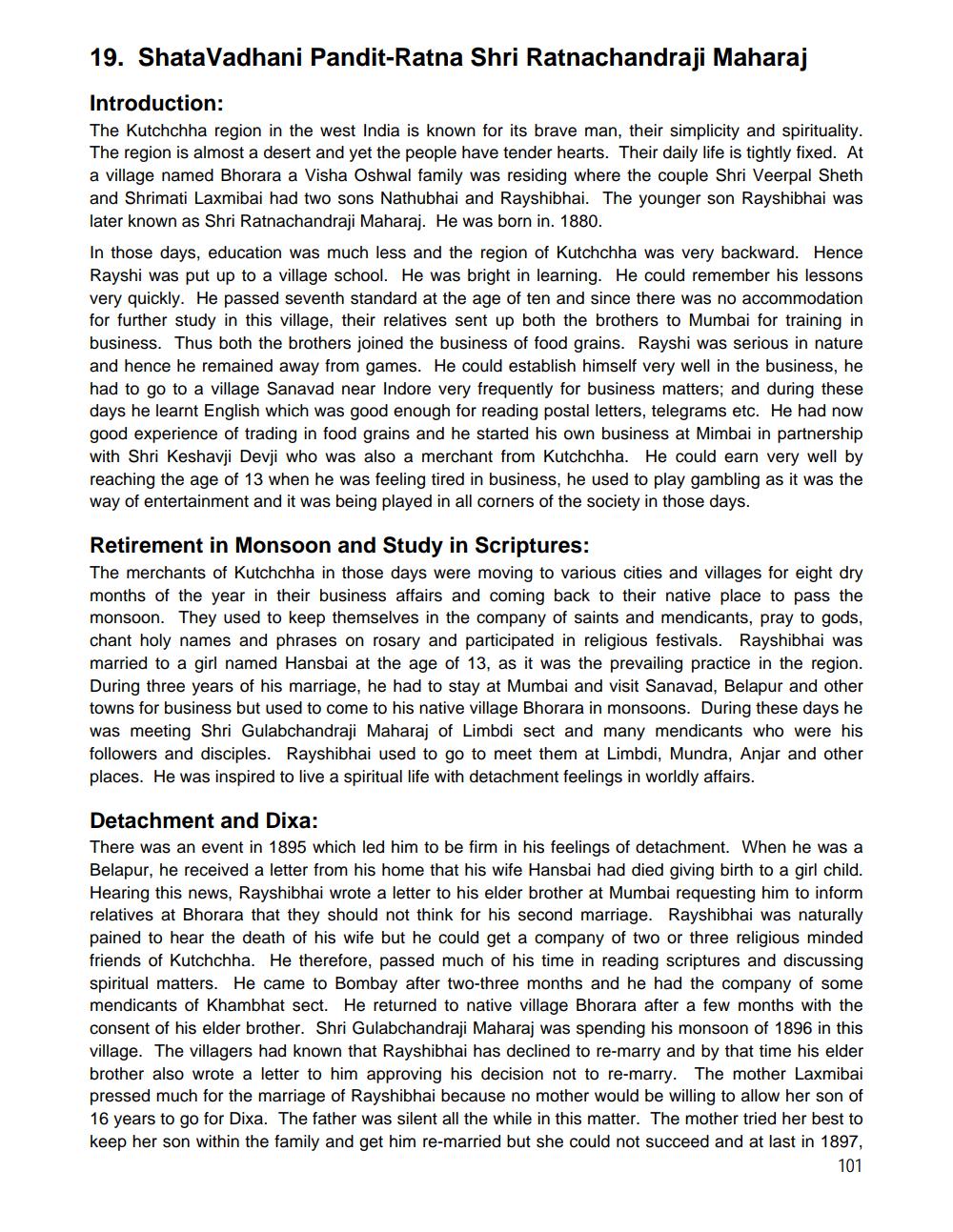________________
19. ShataVadhani Pandit-Ratna Shri Ratnachandraji Maharaj
Introduction: The Kutchchha region in the west India is known for its brave man, their simplicity and spirituality. The region is almost a desert and yet the people have tender hearts. Their daily life is tightly fixed. At a village named Bhorara a Visha Oshwal family was residing where the couple Shri Veerpal Sheth and Shrimati Laxmibai had two sons Nathubhai and Rayshibhai. The younger son Rayshibhai was later known as Shri Ratnachandraji Maharaj. He was born in. 1880. In those days, education was much less and the region of Kutchchha was very backward. Hence Rayshi was put up to a village school. He was bright in learning. He could remember his lessons very quickly. He passed seventh standard at the age of ten and since there was no accommodation for further study in this village, their relatives sent up both the brothers to Mumbai for training in business. Thus both the brothers joined the business of food grains. Rayshi was serious in nature and hence he remained away from games. He could establish himself very well in the business, he had to go to a village Sanavad near Indore very frequently for business matters; and during these days he learnt English which was good enough for reading postal letters, telegrams etc. He had now good experience of trading in food grains and he started his own business at Mimbai in partnership with Shri Keshavji Devji who was also a merchant from Kutchchha. He could earn very well by reaching the age of 13 when he was feeling tired in business, he used to play gambling as it was the way of entertainment and it was being played in all corners of the society in those days.
Retirement in Monsoon and Study in Scriptures: The merchants of Kutchchha in those days were moving to various cities and villages for eight dry months of the year in their business affairs and coming back to their native place to pass the monsoon. They used to keep themselves in the company of saints and mendicants, pray to gods, chant holy names and phrases on rosary and participated in religious festivals. Rayshibhai was married to a girl named Hansbai at the age of 13, as it was the prevailing practice in the region. During three years of his marriage, he had to stay at Mumbai and visit Sanavad, Belapur and other towns for business but used to come to his native village Bhorara in monsoons. During these days he was meeting Shri Gulabchandraji Maharaj of Limbdi sect and many mendicants who were his followers and disciples. Rayshibhai used to go to meet them at Limbdi, Mundra, Anjar and other places. He was inspired to live a spiritual life with detachment feelings in worldly affairs.
Detachment and Dixa: There was an event in 1895 which led him to be firm in his feelings of detachment. When he was a Belapur, he received a letter from his home that his wife Hansbai had died giving birth to a girl child. Hearing this news, Rayshibhai wrote a letter to his elder brother at Mumbai requesting him to inform relatives at Bhorara that they should not think for his second marriage. Rayshibhai was naturally pained to hear the death of his wife but he could get a company of two or three religious minded friends of Kutchchha. He therefore, passed much of his time in reading scriptures and discussing spiritual matters. He came to Bombay after two-three months and he had the company of some mendicants of Khambhat sect. He returned to native village Bhorara after a few months with the consent of his elder brother. Shri Gulabchandraji Maharaj was spending his monsoon of 1896 in this village. The villagers had known that Rayshibhai has declined to re-marry and by that time his elder brother also wrote a letter to him approving his decision not to re-marry. The mother Laxmibai pressed much for the marriage of Rayshibhai because no mother would be willing to allow her son of 16 years to go for Dixa. The father was silent all the while in this matter. The mother tried her best to keep her son within the family and get him re-married but she could not succeed and at last in 1897,
101




